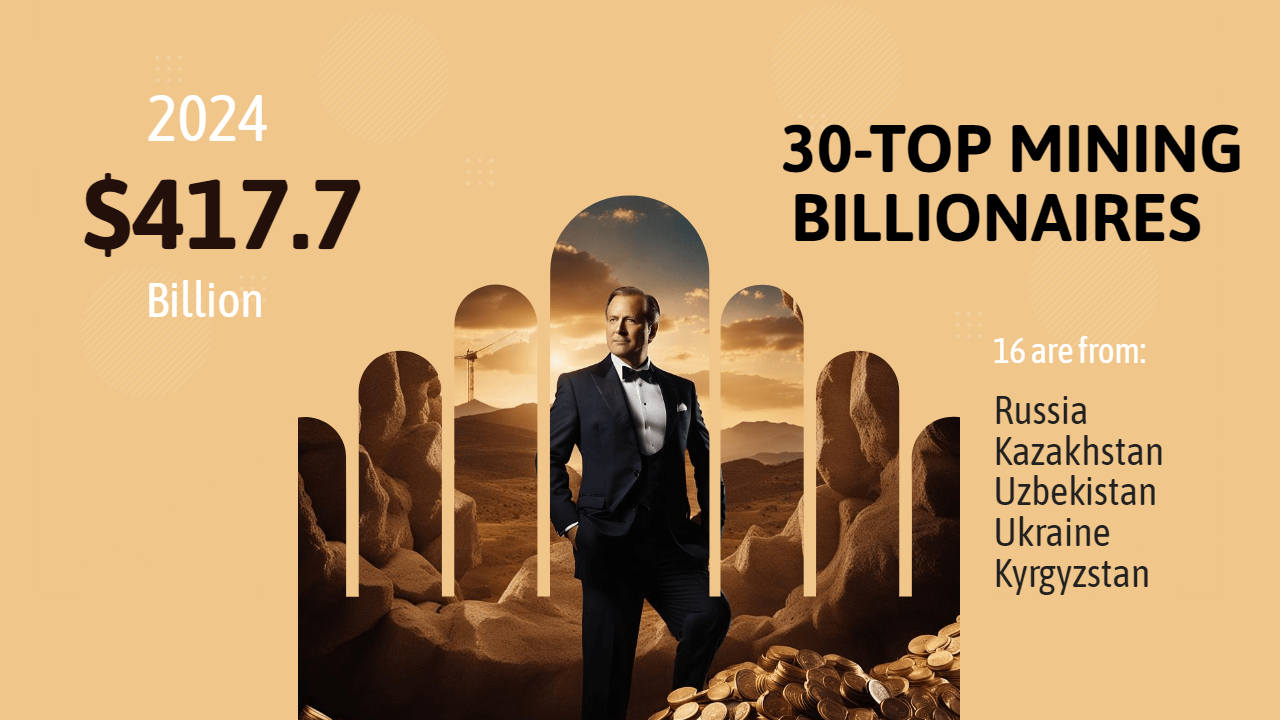30-top mining billionaires are worth $417.7 billion in 2024. 16 billionaires own their wealth to the mineral riches of Russia, Kazakhstan, Ukraine, Uzbekistan, and Kyrgyzstan
Geopolitical Implications of Mining Billionaires’ Wealth in Central Asia, Ukraine, and Russia
In a striking revelation, more than half of the world’s richest mining billionaires have amassed their wealth from their operations in Central Asia, Ukraine, and Russia. Collectively their net worth is $ 154.38 billion or nearly 37% of the $417.7 billion combined wealth of the world’s 30 top mining billionaires. This concentration of wealth and mineral resources in the region has significant implications for global commodity markets, especially in the current geopolitical climate.
Amassing billions in the region’s mining and metals industry
Central Asia, along with Ukraine and Russia, has been for decades a hub for mining activities, with 16 out of 30 billionaires making their fortunes in the sector. Prominent entrepreneurs like Vladimir Lisin, Vladimir Potanin and Alexey Mordashov from Russia, Alisher Usmanov from Uzbekistan, as well as Vladimir Kim from Kazakhstan, are among the top mining billionaires who have amassed substantial wealth from the region’s abundant natural resources. Their influence extends beyond their respective countries, impacting global markets and geopolitical dynamics.
Impact on Commodity Prices and Supply Chains
The current geopolitical environment, marked by high uncertainty and risks, has led to volatile commodity prices. The war in Ukraine has disrupted production and trade, causing surges in prices for energy, fertilisers, metals and grains. Russia’s expanding energy ties in Central Asia are part of its strategy to redirect exports from the West to Asia, following sanctions imposed due to its invasion of Ukraine. This redirection is deeply altering global supply chains and commodity prices.
Geopolitical Implications
The wealth of the region’s 16 mining billionaires is intertwined with the geopolitical landscape. Russia’s use of energy and transport infrastructure as a tool to enhance its influence in Central Asia has been evident, with the country building generating capacities and increasing supplies to the region. This has implications for energy security and political dynamics within Central Asia and beyond.
Before the start of the war in Ukraine in 2022, the European Union and other economies were heavily dependent on Russian energy and commodities. Within the last two years, they have become particularly vulnerable to geopolitical shifts. The sanctions against Russia and the subsequent search for alternative markets have led to a complex web of economic and political relationships that is reshaping global commodity markets.
The concentration of mining wealth in Central Asia, Ukraine, and Russia among a few individuals is not just an economic phenomenon but a factor with profound geopolitical and economic consequences. The current geopolitical tensions, coupled with the strategic manoeuvres of 16 mining billionaires and their home countries, are likely to continue to influence commodity prices and market dynamics for the foreseeable future.
30 Richest Billionaires in Metals and Mining Industry in 2024
- Prajogo Pangestu: $48.5 billion (Indonesia)
- Gina Rinehart: $30.4 billion (Australia)
- Savitri Jindal & family: $30.3 billion (India)
- Germán Larrea Mota Velasco & family: $26.9 billion (Mexico)
- Vladimir Lisin: $26.0 billion (Russia)
- Iris Fontbona & family: $25.1 billion (Chile)
- Andrey Melnichenko & family: $25.0 billion (Russia)
- Vladimir Potanin: $23.7 billion (Russia)
- Alexey Mordashov & family: $22.9 billion (Russia)
- Andrew Forrest & family: $18.8 billion (Australia)
- Lakshmi Mittal: $16.4 billion (United Kingdom)
- Alisher Usmanov: $14.4 billion (Uzbekistan)
- Dang Yanbao: $13.1 billion (China)
- Roman Abramovich & family: $9.7B billion (Russia)
- Nicky Oppenheimer & family: $9.4 billion (South Africa)
- Iskander Makhmudov: $7.9 billion (Russia)
- Ivan Glasenberg: $7.8 billion (Switzerland)
- Andrei Skoch & family: $7.7 billion. (Russia)
- Pavel Tykac: $7.6 billion (Czech Republic)
- Zheng Shuliang & family: $7.3 billion (China)
- Viktor Vekselberg: $7.0 billion (Russia)
- Alexander Abramov: $6.4 billion (Russia)
- Wang Wenyin: $5.9 billion (China)
- Rinat Akhmetov: $5.7 billion (Ukraine)
- Vladimir Kim: $4.6 billion (Kazakhstan)
- Oleg Deripaska: $2.98 billion (Russia)
- Robert Friedland: $2.9 billion (Singapore)
- Alexander Machkevich: $2.4 billion (Kazakhstan)
- Patokh Chodiev: $ 2.1 billion (Kazakhstan)
- Ömürbek Babanov: $ 1.5 billion (Kyrgyzstan)
Sources:
https://ceoworld.biz/2024/02/29/richest-billionaires-in-metals-and-mining-industry-february-29-2024/
https://www.forbes.com/
Top 10 Richest People in Indonesia; Forbes December 2023 Version – En.tempo.co
Ömürbek Babanov – Wikipedia

